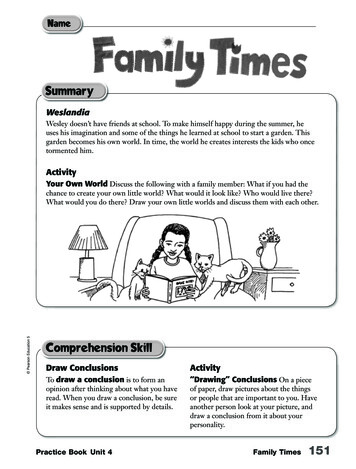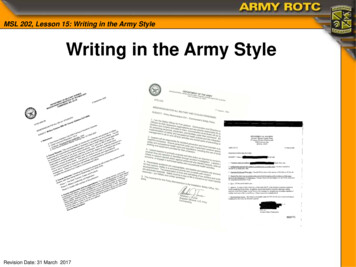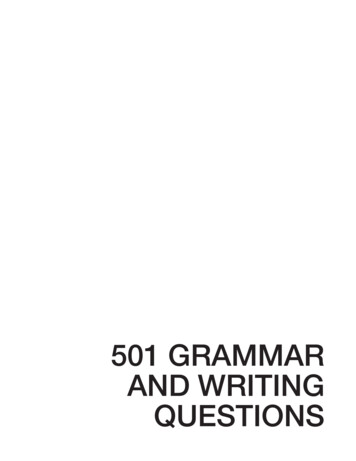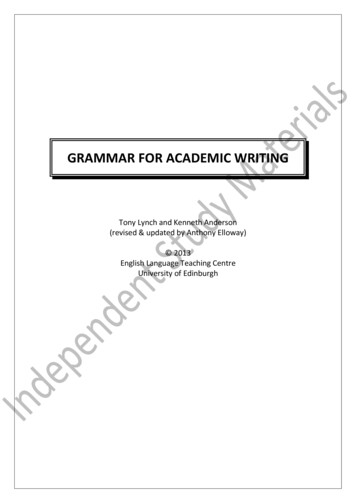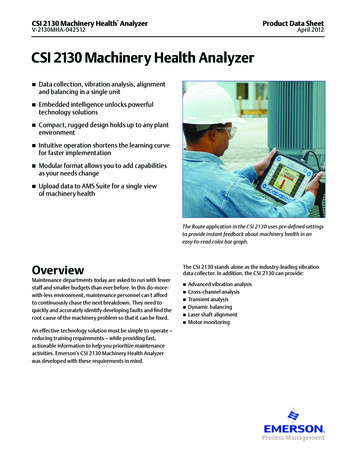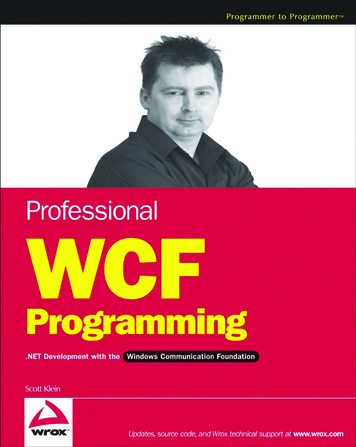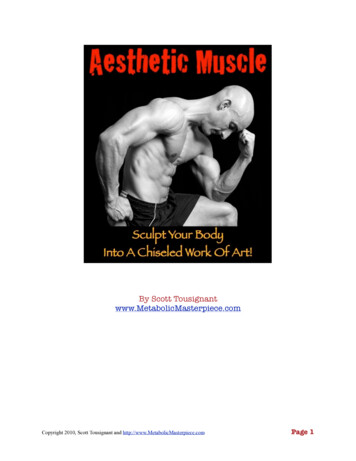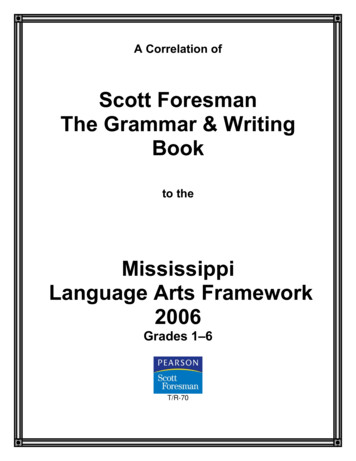
Transcription
A Correlation ofScott ForesmanThe Grammar & WritingBookto theMississippiLanguage Arts Framework2006Grades 1–6T/R-70
IntroductionThis document demonstrates how Scott Foresman The Grammar &Writing Book meets the objectives of the Mississippi Language ArtsFramework, 2006. Correlation page references are to the Teacher’sEdition. Lessons in the Teacher’s Edition contain facsimile pages from theStudent Edition.The Grammar & Writing Book extends grammar and writing instruction inthe Scott Foresman Reading Street Student Edition with additional practice.The Grammar & Writing Book can be used with Scott Foresman ReadingStreet or as a stand-alone language arts component.
Table of ContentsGrade One .1Grade Two .9Grade Three .16Grade Four .24Grade Five 32Grade Six .40
Scott ForesmanThe Grammar & Writing Bookto theMississippi Language Arts Framework 2006Grade OneCOMPETENCIES and Objectives1. The student will use word recognition and vocabulary (word meaning)skills to communicate.a. The student will apply knowledge of concepts about print.1) Point to words in text when reading aloud matching spoken words to print.The Grammar & Writing Book: The students have the opportunity to point towords when reading aloud or when the teacher is reading to them.Representative pages: 50, 51, 54, 55, 56, 57, 58, 59, 60, 61, 62, 63, 64, 65, 66, 6869, 70, 72-73, 76, 78-79, 81, 86, 87, 92-93, 108, 115, 117, 122-123, 126, 144, 145,164, 192, 210, 212-213, 2282) Distinguish between uppercase and lowercase letters.The Grammar & Writing Book: 50-51, 52, 53, 74-75, 76-77, 81, 82-83, 92-93, 94-95,96, 97, 98-99, 100-101, 104-105, 106-107, 206-207, 208, 254-2553) Identify and use title page, title, author, illustrator, and table of contents of abook.The Grammar & Writing Book: 163, 181, 187, 205, 2294) Identify dialogue in connected text.b. The student will apply knowledge of phonological and phonemic awareness.(Phonological and phonemic awareness skills are oral skills. Once the skills arepaired with print, they become phonics activities).1) Identify and produce rhyming words orally that include consonant blendsand digraphs (e.g., flat/splat, trap/snap, sing/ring).The Grammar & Writing Book: 144-1452) Identify, blend, and segment syllables within spoken words (e.g., clap thesyllables in “bi-cy-cle,” bas ket ball basketball, telephone tel e phone).Grade One1
Scott ForesmanThe Grammar & Writing BookMississippi Language ArtsFramework3) Identify and count the number of syllables in a spoken word.4) Identify orally beginning, final, and medial sounds in one-syllable words(e.g., /ch/ in chat, /sh/ in wish, /ē/ in read).5) Distinguish short and long vowel sounds in spoken one-syllable words (e.g.,bĭt/bīte, hŏp/hōpe).6) Blend and segment the phonemes in words containing two to four phonemes(e.g., /b/ /ă/ /t/ bat, treat /t/ /r/ /ē/ /t/).7) Blend and segment sounds in spoken words containing initial and finalblends.8) Add or delete a phoneme to change a spoken word (e.g., Add /b/ to “at” bator take /k/ from “cat" at).The Grammar & Writing Book: 144-145c. The student will use word recognition skills.1) Generate the sounds from all the letters and letter patterns (includingconsonant blends, consonant digraphs, short and long vowel patterns), andblend those sounds into recognizable words.The Grammar & Writing Book: 84, 86-87, 88-89, 90-91, 92-93, 102-103, 110-111,112-113, 116-117, 118, 119, 122-123, 124, 125, 126, 128-129, 131, 132, 134-135,137, 146-147, 149, 158-159, 161, 164-165, 170-171, 174, 176-177, 179, 183, 188189, 1912) Begin to use knowledge of vowel digraphs, diphthongs, and r-controlledletter-sound correspondences to decode unknown words.3) Read words derived from common word families (e.g., -it, -at, -ite, -ate).The Grammar & Writing Book: 144-1454) Begin to use common spelling patterns to make new words (e.g., make, take,lake, cake, etc.).The Grammar & Writing Book: 144-1455) Use inflectional endings (e.g., -s, -es, -ed, or -ing) to produce new words.The Grammar & Writing Book: 122-123, 124-125, 126, 127, 128-129, 130, 131, 132,1336) Identify simple compound words (e.g., dog house doghouse).The Grammar & Writing Book: 87, 91, 102Grade One2
Scott ForesmanThe Grammar & Writing BookMississippi Language ArtsFramework7) Identify simple contractions correctly (e.g., can not can't, has not hasn’t, did not didn’t).The Grammar & Writing Book: 152-153, 154-155, 2448) Read 100 to 200 high frequency and/or irregularly spelled words. A firstgrader should read approximately 40 to 60 words correct per minute by the endof first grade.The Grammar & Writing Book: 22-23, 24, 252-253d. The student will use syllabication types (e.g., open, closed, r-controlled, vowelteam, vowel consonant e, consonant plus le) to analyze words.e. The student will begin to identify and use roots and affixes (e.g., un-, re-, -s, es, -ed, -ing) to decode and understand words.The Grammar & Writing Book: 110-111, 112-113, 114-115, 116-117, 119f. The student will develop and apply knowledge of words and word meanings tocommunicate.1) Identify and sort pictures and words into basic categories.The Grammar & Writing Book: 86-872) Recognize and explain word relationships within categories of words.The Grammar & Writing Book: 86-87, 93, 105, 111, 117g. The student will begin to identify and use synonyms, antonyms, andhomonyms.h. The student will use context to determine the meanings of unfamiliar ormultiple meaning words.The Grammar & Writing Book: 163i. The student will use reference materials to find, to determine the meaning of, topronounce, or to spell unknown words (e.g., picture dictionary, personaldictionary, elementary dictionary, teacher and/or peer as a resource).The Grammar & Writing Book: Grammar Patrol, 243-251, Frequently Misspelled Words,252-253.Grade One3
Scott ForesmanThe Grammar & Writing BookMississippi Language ArtsFramework2. The student will apply strategies and skills to comprehend, respond to,interpret, or evaluate a variety of texts of increasing length, difficulty, andcomplexity.a. The student will use text features, parts of a book, and text structures toanalyze text.1) Text features – titles, illustrations, headings, graphs, etc.The Grammar & Writing Book: 55, 61, 62, 64, 65, 67, 70, 73, 80, 85, 86-87, 88-89,91, 92-93, 94-95, 97, 102-103, 110, 112-113, 121, 127, 151, 158, 164, 165, 185, 202,205, 211, 217, 221, 2292) Parts of a book – title page, title, author, illustrator, table of contents, etc.The Grammar & Writing Book: 163, 181, 187, 205, 2293) Text structures – fiction, nonfiction, description, sequential order, etc.The Grammar & Writing Book: 163, 181, 187, 205, 229b. The student will understand, infer, and make simple predictions.1) Answer and generate who, what, when, where, why, and how questions.The Grammar & Writing Book: 2072) Answer and generate questions about characters, settings, and events.The Grammar & Writing Book: 1633) Make simple inferences based on information from narrative and/orinformational text.The Grammar & Writing Book: 163, 2294) Identify the main idea of a simple story or topic of an informational text.The Grammar & Writing Book: 79, 1635) Make a prediction about narrative or informational text and confirm or revisethe prediction.6) Use key words in text to justify prediction(s).c. The student will recognize or generate an appropriate summary orparaphrasing of the events or ideas in text, citing text-based evidence.1) Retell a story including characters, setting, and important events.The Grammar & Writing Book: 1632) Retell the correct sequence of events in narrative and/or informational text.The Grammar & Writing Book: 6-7, 8-9, 68-69, 163Grade One4
Scott ForesmanThe Grammar & Writing BookMississippi Language ArtsFrameworkd. The student will analyze, interpret, compare, or respond to increasinglycomplex literary and informational text, citing text-based evidence.1) Interpret text through moving, drawing, speaking, acting, or singing.The Grammar & Writing Book: 77, 79, 2292) Make connections between self and text or text and text after sharing text orreading text independently.The Grammar & Writing Book: 13, 26, 31, 36, 41, 2293) Compose visual images based on text.The Grammar & Writing Book: 12, 16-17, 75, 77, 794) Identify favorite passages.The Grammar & Writing Book: 1633. The student will express, communicate, or evaluate ideas effectively.a. The student will use an appropriate composing process (e.g., planning,drafting, revising, editing, publishing/sharing) to compose or edit.1) Planning Use graphic organizers to generate and organize ideas.The Grammar & Writing Book: 55, 61, 67, 73, 79, 85, 91, 97, 103, 109, 115,121, 127, 133, 139, 145, 151, 157, 163, 169, 175, 181, 187, 193, 199, 205, 211, 217,223, 229, 232, 234, 236, 238, 240, TR28-TR322) Drafting Put thoughts on paper using words and sentences.The Grammar & Writing Book: 51, 55, 61, 67, 73, 79, 85, 91, 97, 103, 109, 115,121, 127, 133, 139, 145, 151, 157, 163, 169, 175, 181, 187, 193, 199, 205, 211, 217,223, 229, 232, 234, 236, 238, 2403) Revising Revise compositions by clarifying and adding details.The Grammar & Writing Book: 24-25, 51, 55, 61, 67, 73, 79, 85, 91, 97, 103, 109,115, 121, 127, 133, 139, 145, 151, 157, 163, 169, 175, 181, 187, 193, 199, 205, 211,217, 223, 229, 232, 234, 236, 238, 240Grade One5
Scott ForesmanThe Grammar & Writing BookMississippi Language ArtsFramework4) Editing Edit for capitalization and punctuation.The Grammar & Writing Book: 24-25, 51, 55, 61, 67, 73, 79, 85, 91, 97, 103, 109,115, 121, 127, 133, 139, 145, 151, 157, 163, 169, 175, 181, 187, 193, 199, 205, 211,217, 223, 229, 232, 234, 236, 238, 2405) Publishing/Sharing Share compositions by displaying, retelling, and/or reading ideas.The Grammar & Writing Book: 51, 55, 61, 67, 73, 79, 85, 91, 97, 103, 109, 115,121, 127, 133, 139, 145, 151, 157, 163, 169, 175, 181, 187, 193, 199, 205, 211, 217,223, 229, 232, 234, 236, 238, 240b. The student will compose a description of a person, place, or thing.1) Compose drawings/visual images and orally describe.The Grammar & Writing Book: 53, 55, 67, 116, 1652) Compose oral and written descriptions of a familiar person, place, or thing.The Grammar & Writing Book: 31-37, 115, 151, 157, 175, 193, 211, 236-237c. The student will compose a narrative with a beginning, middle, and end.1) Compose retellings/stories with a beginning, middle, and end.The Grammar & Writing Book: 26-30, 67, 73, 79, 133, 169, 229, 232-233, TR282) Compose drawings/visual images to tell stories with a beginning, middle,and end.The Grammar & Writing Book: 16-17, 73, 79, 115, 121, 145, 151, 157, 163, 169,175, 181, 193, 199, 205, TR28-TR32d. The student will compose a short informational text based on a familiar topic,including but not limited to:1) ReportsThe Grammar & Writing Book: 205, 234-2352) Letters, thank you notes, invitationsThe Grammar & Writing Book: 36, 2223) Functional texts (e.g, labels, directions, shopping lists, etc.)The Grammar & Writing Book: 91, 103, 109, 187, 199, 211, 234-235Grade One6
Scott ForesmanThe Grammar & Writing BookMississippi Language ArtsFramework4. The student will apply Standard English to communicate.a. The student will use Standard English grammar.1) Begin to use nouns (e.g., singular, plural)The Grammar & Writing Book: 86-89, 90, 92-95, 96, 98-101, 102, 104-107, 110-113,116-119, 120, 244-2452) Begin to use verbsThe Grammar & Writing Book: 122-125, 126, 128-131, 134-137, 140-143, 146-149,2503) Begin to use articles and conjunctions4) Begin to use adjectivesThe Grammar & Writing Book: 158-161, 162, 164-167, 170-173, 174, 176-179, 182185, 188-191, 2415) Begin to use pronounsThe Grammar & Writing Book: 212-215, 218-221, 224-227, 246-246b. The student will use Standard English mechanics.1) Begin to use appropriate end punctuation (e.g., period, question mark,exclamation point)The Grammar & Writing Book: 50-53, 74-77, 80-83, 98-101, 194-197, 200-203, 2062092) Begin to use periods in common abbreviations (e.g., Mr., Mrs., Dr., days ofthe week, months of the year)The Grammar & Writing Book: 98-1013) Begin to use commas (e.g., dates)4) Begin to use apostrophes (e.g., contractions)The Grammar & Writing Book: 152-155, 2445) Begin to use colon in notation of time6) Begin to use capitalization (e.g., first word in a sentence, proper nouns, daysof the week, months of the year, the pronoun “I”)The Grammar & Writing Book: 50-53, 74-77, 80-83, 92-95, 98-101, 104-107, 194-197,200-203, 206-209, 218-221Grade One7
Scott ForesmanThe Grammar & Writing BookMississippi Language ArtsFramework7) Spell words commonly found in first grade level text.The Grammar & Writing Book: 24-25, 26-27, 28-29, 30, 33, 34, 35, 38, 39, 40, 42, 43,44, 458) Develop handwriting skills. Position paper in order to write in a left to right progression moving from topto bottom on the page. Write first and last name legibly. Write lowercase and uppercase letters legibly. Write words and sentences legibly using proper spacing.The Grammar & Writing Book: The book includes weekly writing lessons, a Writer’sGuide, writing for tests lessons, and a Grammar Patrol handbook. The D’NealianAlphabet and Manuscript Alphabet are found on pp. 254-255.c. The student will use varied sentence structures.1) Analyze sentences to determine purpose (e.g., declarative/telling,interrogative/question, exclamatory/strong feeling).The Grammar & Writing Book: 74-77, 80-83, 84, 194-197, 198, 200-203, 204, 2062092) Compose sentences with a variety of purposes (e.g., declarative/telling,interrogative, question, exclamatory/strong feeling).The Grammar & Writing Book: 4-5, 18-19, 20-21, 27, 28, 29, 30, 32, 33, 34, 35, 37,38, 39, 40, 42, 43, 44, 45, 74-77, 80-83, 84, 194-197, 198, 200-203, 204, 206-2093) Compo
Scott Foresman Mississippi Language Arts The Grammar & Writing Book Framework 2. The student will apply strategies and skills to comprehend, respond to, interpret, or evaluate a variety of texts of increasing length, difficulty, and complexity. a. The student will use text features, parts of a book, and text structures to analyze text. 1) Text features – titles, illustrations, headings .
